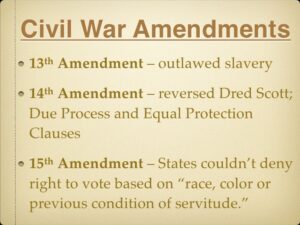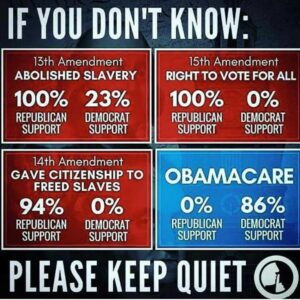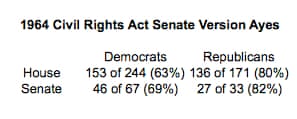The left claims that the parties switched sides at some point in the 60s or 70s. It’s funny they can’t pinpoint an event that indicates a switch of parties. It’s obvious why they can’t though, because ‘the Big Switch is a big lie’ as Dinesh D’Souza would put it.
The Republican Party emerged in 1854 to combat the Kansas–Nebraska Act and the expansion of slavery into American territories. The early Republican Party consisted of African-Americans, northern white Protestants, businessmen, professionals, factory workers, and farmers. The GOP was pro-business, and it supported banks, the gold standard, railroads, and high tariffs; the party opposed the expansion of slavery.
(Source – Wikipedia)
The Civil War would be a post of its own. All that really needs to be said about it is that the Republican’s 360,222 Union fighters died to save the Union and ultimately end slavery. The New York Times reports that number was the old standard and has been since increased. It’s a conservative number.
Here’s a little background on the resulting Amendments post Civil War.

Thirteenth Amendment

Although Congress abolished slavery in the District of Columbia in 1862, and President Abraham Lincoln’s Emancipation Proclamation ended the practice of slavery in rebellious states in 1863, at war’s end in 1865 the question of slavery had not been resolved at the national level. The federal government required new state constitutions in former Confederate states to include the abolition of slavery, but there was nothing to prevent states from reinstituting the practice with revised state constitutions. Senators Lyman Trumbull of Illinois, Charles Sumner of Massachusetts, and John Henderson of Missouri, sponsored resolutions for a constitutional amendment to abolish slavery nationwide. The Thirteenth Amendment—passed by the Senate on April 8, 1864; by the House on January 31, 1865; and ratified by the states on December 6, 1865—abolished slavery “within the United States, or any place subject to their jurisdiction.” Congress required former Confederate states to ratify the Thirteenth Amendment as a condition of regaining federal representation.
Fourteenth Amendment

Ratified July 9, 1868, the Fourteenth Amendment granted citizenship to all persons “born or naturalized in the United States,” including former enslaved persons, and provided all citizens with “equal protection under the laws,” extending the provisions of the Bill of Rights to the states. The amendment authorized the government to punish states that abridged citizens’ right to vote by proportionally reducing their representation in Congress. It banned those who “engaged in insurrection” against the United States from holding any civil, military, or elected office without the approval of two-thirds of the House and Senate. The amendment prohibited former Confederate states from repaying war debts and compensating former slave owners for the emancipation of their enslaved people. Finally, it granted Congress the power to enforce this amendment, a provision that led to the passage of other landmark legislation in the 20th century, including the Civil Rights Act of 1964, and the Voting Rights Act of 1965. Congress required former Confederate states to ratify the Fourteenth Amendment as a condition of regaining federal representation.
Fifteenth Amendment
As a member of the Senate Committee on the Judiciary, William Stewart of Nevada guided the Fifteenth Amendment through the Senate. Ratified February 3, 1870, the amendment prohibited states from disenfranchising voters “on account of race, color, or previous condition of servitude.” The amendment left open the possibility, however, that states could institute voter qualifications equally to all races, and many former confederate states took advantage of this provision, instituting poll taxes, and literacy tests, among other qualifications.
The Reconstruction amendments to the Constitution extended new constitutional protections to African Americans, though the struggle to fully achieve equality would continue into the 20th century.
(Source – Senate.gov)
The 13th amendment only 16/80 Democrats voted for it. The 14th and 15th amendments not a single Democrat voted for it.

This is where it gets interesting from a Republican VS Democrat Standpoint. President Johnson (D) Vetoed the Civil Right Act of 1864! The Republicans, fortunately, had enough votes to overturn the veto.
The Republicans also wanted to give former slaves reparations. They attempted to give reparations in the form of Special Field Order #15, known commonly as 40 Acres and a Mule. So when Democrats today spout that they want Reparations for slavery, know that it’s a ruse to literally buy the black vote. The Democrats already shot down reparations when the Republicans attempted to give it to them. The idea of reparations would be impossible to administrate today.
Once Lincoln (R) was assassinated and Johnson (D) took over, the progress to completely integrating former slaves took a hard turn for the worse. The Democrats turned to intimidation and threats, much the same as they are using today. Democrats fought against the new freedom that former slaves had, so the KKK formed, they kept black, largely Republican, voters from the poles through coercion. They moved on the Jim Crow, Segregation, Black Codes, and other means to oppress the newly freed slaves. And they kept it up for a Century!
Prior to the 1930s, the black vote was about 90% Republican. Post the New Deal the black vote went 70% Democrat due to indirect benefits of the new deal. “Indirectly,” because the New Deal excluded most black people. FDR made a deal with the racist Southern Democrats for it to exclude most black people. The Great Depression affected poor black people more than other groups of people. The meager benefits gained by the New Deal were enough to gain many of their votes.
Lyndon Baines Johnson, another staunch racist, took note of what happened in the 1930s. He realized that the South was becoming less racist and he could no longer rely on the racist Democrat vote because as they were becoming less racist, many of the voters we’re switching to the Republican Party. So LBJ and his Great Society cater to the black vote even though LBJ was himself a racist, quoted as saying “I’ll have these (black people) voting Democrat for 200 years,” he knew he needed black vote to retain power in the Democrat Party.
The Civil Rights Act of 1964 (Pub.L. 88–352, 78 Stat. 241, enacted July 2, 1964) is a landmark civil rights and labor law in the United States that outlaws discrimination based on race, color, religion, sex, or national origin.[4] It prohibits unequal application of voter registration requirements, and racial segregation in schools, employment, and public accommodations.
(Source – Wikipedia)
The Civil Rights Act — which is best known for barring discrimination in public accommodations — passed the House on Feb. 10, 1964 by a margin of 290-130. When broken down by party, 61 percent of Democratic lawmakers voted for the bill (152 yeas and 96 nays), and a full 80 percent of the Republican caucus supported it (138 yeas and 34 nays).
When the Senate passed the measure on June 19, 1964, — nine days after supporters mustered enough votes to end the longest filibuster in Senate history — the margin was 73-27. Better than two-thirds of Senate Democrats supported the measure on final passage (46 yeas, 21 nays), but an even stronger 82 percent of Republicans supported it (27 yeas, 6 nays).
(Source – Politifact)
Keep in mind that the Democrats had the majority, and could not get a passed on their own. Also, keep in mind that most of the elements of the 1964 bill had already been passed in 1864 by Republicans, which is the one that the Democrats obstructed.

So to recap, the black vote went from 10% Democrat to 70% Democrat in the 1930s and from 70% Democrat to 90% Democrat in the 1960s all during this time the Democrat Party was still the party of racism.
The left loves to call Nixon’s Souther Strategy the point at which the parties “switched.” The Southern Strategy was a continuation of LBJs strategy because the South was becoming less racist. Nixon wanted to pick up former Democrats who were no longer racist. As evidence that he South was becoming less racist at that time the deep south was lost by Nixon to Goldwater, but Nixon won the rust belt.
One would think if there were a “big switch” Republican Senators would become Democrat senators and Democrat Senators will become Republican Senators. There were only a couple seats that changed parties and that was Strom Thurmond from D to R in the ’70s, and Wayne Morse from R to D in the ’60s.
Speaking of Nixon, do some research the Nixon Administration was the administration that put affirmative action laws in place. So how can Nixon and be racist when he signed a bill to help black people?
Democrats to this day divide the population by race instead of treating everybody as an individual with individual merits. So, called “White Privilege” is an example of this racism. White privilege is a “politically correct” way of saying that white people are superior to other races. In short, it’s white supremacy! This is touted by the Democrat party today! Republicans reject this train of thought!
Contrary to the Democratic narrative they are doing what they always do and they project their sins at another party. The Democrat Party is and always has been the party of racism. Which includes “Reverse Racism.” (ie Don Lemmon)
The Republican Party started as the party of individual liberty, limited government. The Democrat party has been the party of the collective, and centralized government. Both parties still hold these values and have always held these values. The Marxist Leftists are again pushing a false narrative and a pseudo-event.
4 Ye have not yet resisted unto blood, striving against sin.
-Hebrews 12:4 King James Version (KJV)















